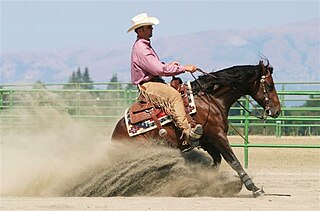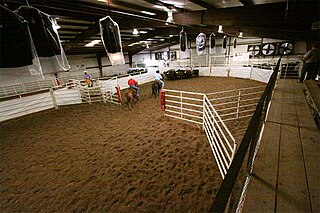
The Texas Longhorn is an American breed of beef cattle, characterized by its long horns, which can span more than 8 ft (2.4 m) from tip to tip. It derives from cattle brought from the Iberian Peninsula to the Americas by Spanish conquistadores from the time of the Second Voyage of Christopher Columbus until about 1512. For hundreds of years the cattle lived a semi-feral existence on the rangelands; they have a higher tolerance of heat and drought than most European breeds. It can be of any color or mix of colors. In some 40% of the cattle it is some shade of red, often a light red; the only shade of red not seen is the deep color typical of the Hereford.

Equestrianism, commonly known as horse riding or horseback riding, includes the disciplines of riding, driving, and vaulting. This broad description includes the use of horses for practical working purposes, transportation, recreational activities, artistic or cultural exercises, and competitive sport.

Rodeo is a competitive equestrian sport that arose out of the working practices of cattle herding in Spain and Mexico, expanding throughout the Americas and to other nations. It was originally based on the skills required of the working vaqueros and later, cowboys, in what today is the western United States, western Canada, and northern Mexico. Today, it is a sporting event that involves horses and other livestock, designed to test the skill and speed of the cowboys and cowgirls. American-style professional rodeos generally comprise the following events: tie-down roping, team roping, steer wrestling, Steer roping, saddle bronc riding, bareback bronc riding, bull riding and barrel racing. The events are divided into two basic categories: the rough stock events and the timed events. Depending on sanctioning organization and region, other events such as breakaway roping, goat tying, and pole bending may also be a part of some rodeos. The "world's first public cowboy contest" was held on July 4, 1883, in Pecos, Texas, between cattle driver Trav Windham and roper Morg Livingston.

A cowboy is an animal herder who tends cattle on ranches in North America, traditionally on horseback, and often performs a multitude of other ranch-related tasks. Cattle drives ensure the herds health in finding pasture and bring them to market. The historic American cowboy of the late 19th century arose from the vaquero traditions of northern Mexico and became a figure of special significance and legend. A subtype, called a wrangler, specifically tends the horses used to work cattle. In addition to ranch work, some cowboys work for or participate in rodeos. Cowgirls, first defined as such in the late 19th century, had a less well-documented historical role, but in the modern world work at identical tasks and have obtained considerable respect for their achievements. Cattle handlers in many other parts of the world, particularly in South America and stockmen and jackaroos in Australia, perform work similar to the cowboy.

Bull riding is a rodeo sport that involves a rider getting on a bucking bull and attempting to stay mounted while the animal tries to buck off the rider.

A horse show is a judged exhibition of horses and ponies. Many different horse breeds and equestrian disciplines hold competitions worldwide, from local to the international levels. Most horse shows run from one to three days, sometimes longer for major, all-breed events or national and international championships in a given discipline or breed. Most shows consist of a series of different performances, called classes, wherein a group of horses with similar training or characteristics compete against one another for awards and, often, prize money.

Reining is a western riding competition for horses where the riders guide the horses through a precise pattern of circles, spins, and stops. All work is done at the lope, or the gallop. Originating from working cattle, reining requires the horse to be responsive and in tune with its rider, whose aids should not be easily seen, and judges the horse on its ability to perform a set pattern of movements. The horse should be willingly guided or controlled with little or no apparent resistance and dictated to completely. A horse that pins his ears, conveys a threat to his rider, refuses to go forward, runs sideways, bounces his rear, wrings his tail in irritation, or displays an overall poor attitude is not being guided willingly, and is judged accordingly. If a horse jogs or breaks gait it is a 0.

Campdrafting is a unique Australian sport involving a horse and rider working cattle. The riding style is Australian stock, somewhat akin to American Western riding and the event is similar to the American stock horse events such as cutting, working cow horse, team penning, and ranch sorting.

Cutting is a western-style equestrian competition in which a horse and rider work together before a judge or panel of judges to demonstrate the horse's athleticism and ability to handle cattle. Modern competition utilizes a 2+1⁄2 minute performance, called a "run." Each contestant is assisted by four helpers: two are designated as turnback riders, who help to keep cattle from running off to the back of the arena, the other two are designated as herd holders to keep the cattle bunched together and prevent potential strays from escaping into the work area. Cutting cattle are typically young steers and heifers that customarily range in size from 400 to 650 lb. They usually are of Angus or Hereford lineage though may be a mix of crossbred beef cattle, including Charolais Braford or Brahman lineage.

Team penning is a western equestrian sport that evolved from the common ranch work of separating cattle into pens for branding, doctoring, or transport.

Western riding is considered a style of horse riding which has evolved from the ranching and welfare traditions which were brought to the Americas by the Spanish Conquistadors, as well as both equipment and riding style which evolved to meet the working needs of the cowboy in the American West. At the time, American cowboys had to work long hours in the saddle and often over rough terrain, sometimes having to rope a cattle using a lariat, also known as a lasso. Because of the necessity to control the horse with one hand and use a lariat with the other, western horses were trained to neck rein, that is, to change direction with light pressure of a rein against the horse's neck. Horses were also trained to exercise a certain degree of independence in using their natural instincts to follow the movements of a cow, thus a riding style developed that emphasized a deep, secure seat, and training methods encouraged a horse to be responsive on very light rein contact.

A cutting horse is a stock horse, typically an American Quarter Horse, bred and trained for cutting, a modern equestrian competition requiring a horse and rider to separate a single cow from a herd of cattle and prevent it from getting back to the herd. One of the desired qualities in a cutting horse is "cow sense," described as an innate ability to read a cow, eye to eye, in anticipation of each move. The cutting horse has its roots in the historic cattle ranching industry, where horses with specialized cattle-handling skills were crucial for the work of the cowboy.
History of rodeo tracks the lineage of modern Western rodeo.

Working cow horse or reined cow horse is a type of Western riding competition in which horse and rider are tested for ability to work cattle. It is organised by the National Reined Cow Horse Association in North America, and by the European Reined Cow Horse Association in Europe. Horses are judged on accuracy, timing, and responsiveness.

A stock horse is a horse of a type that is well suited for working with livestock, particularly cattle. The related cow pony or cow horse is a historic phrase, still used colloquially today, referring to a particularly small agile cattle-herding horse; the term dates to 1874. The word "pony" in this context has little to do with the animal's size, though the traditional cow pony could be as small as 700 to 900 pounds and less than 14 hands high.
The National Reining Horse Association (NRHA) is an American nonprofit organization whose purpose is to promote the reining horse.

Ranch sorting is a western-style equestrian sport that evolved from the common ranch work of separating cattle into pens for branding, doctoring, or transport. Ranch Sorting is an event that pits a team of two riders on horseback against the clock. Teamwork is the key with both riders working in harmony to cut out the correct cattle and drive them to the pen while keeping the wrong numbered cattle back. There are several variations of ranch sorting with one, two or three riders on the team, but all require sorting the cattle from one pen to the other in the correct order.
A ranch rodeo is a traditional type of rodeo in which teams of cowboys or cowgirls from different ranches compete against each other in events based on the type of work they do every day.
Fay Owen "Buster" Welch was an American cutting horse trainer and inductee into the NCHA Members Hall of Fame, American Quarter Horse Hall of Fame, NCHA Rider Hall of Fame, and Texas Cowboy Hall of Fame. Buster was chosen as the recipient of the 2012 National Golden Spur Award for his "outstanding contributions to the ranching and livestock industry".

The National Reined Cow Horse Association (NRCHA) is an equestrian organization in Pilot Point, Texas, United States, that began by promoting and staging Working cow horse events.
















